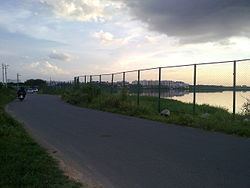Max. length 3.6 km (2.2 mi) Surface area 3.61 km (1.39 sq mi) Surface elevation 921 m Catchment area 148 km² Cities Bengaluru | Max. width 1.4 km (0.87 mi) Area 3.61 km² Length 3.6 km Width 1.4 km | |
 | ||
Similar Hesaraghatta Lake, Ulsoor, Lal Bagh, Madhavan Park, Bannerghatta National Park | ||
Dna fire smoke engulf bellandur lake in bengaluru
Bellandur Lake is a lake in the suburb of Bellandur in the southeast of the city of Bangalore and is the largest lake in the city. It is a part of Bellandur drainage system that drains the southern and the southeastern parts of the city. The lake is a receptor from three chains of lakes upstream, and has a catchment area of about 148 square kilometres (37,000 acres). Water from this lake flows further east to the Varthur Lake, from where it flows down the plateau and eventually into the Pinakani river basin. It is currently highly polluted with sewage, and in May 2015 the foam covering the water surface caught fire and burned for hours.
Contents
- Dna fire smoke engulf bellandur lake in bengaluru
- Map of Bellandur Lake Belur Nagasandra Bellandur Bengaluru Karnataka 560103
- The quint bengaluru s bellandur lake catches fire yet again
- Geography
- Flora Fauna
- Impact of Urbanisation
- Conservation Efforts
- References
Map of Bellandur Lake, Belur Nagasandra, Bellandur, Bengaluru, Karnataka 560103
The quint bengaluru s bellandur lake catches fire yet again
Geography
Bellandur Lake is a major water body which is located in one of the three main valleys of Bangalore. It forms a part of Ponnaiyar River catchment, and water from Bellandur flows to Varthur Lake, ultimately joining the Pennar River. Currently, most of Bengaluru's treated and untreated sewage is let into this lake, severely polluting it, resulting in a depletion of wildlife in and around the lake.Impact of Urbanization with ongoing to fulfill the requirements and greed of Humans has cost the lake to lose its glory, forcing the fauna which was previously dwelling to change habitats. Residential and Commercial activities in and around the region has resulted in increasing the silt deposition in and the Surrounding location of lake has been major cause for loss of under-ground water recharge.
Flora & Fauna
The lake was a prominent catchment area with a good green cover and was a watering hole for the region's numerous, indigenous wildlife. But 30 years of unplanned urbanization have taken a toll on the lake, now several species are gone from the area, including kingfishers, parrots, parakeets, wood pigeons, kites, king cobras, rat snakes, monitor lizards. As more and more large apartment complexes come up on the lakes shores, more such species will disappear.
Impact of Urbanisation
The land around the lake is used as a dumping ground by builders and housing societies in the area. The combination of all these factors have led to a decline in the once robust eco-system of the lake which now resembles a stinking cesspool. Residents in neighboring areas complain of an odious stench that rises from the lake as a result of uninhibited sewage and chemical dumping from near by industrial units.
Conservation Efforts
Time and again the Bangalore Government has attempted to take positive action to save the lake, but in the end, the maximum efforts come from citizens who plan plantation drives and cleanup programs around the lake. RTI activists like CH Ram have repeatedly brought the Lake's plight to the BBMP's attention, and have been promised affirmative action to save the lake. In 2010, the BBMP adopted a Lake Rejuvenation Program. Under this program, the lake received new fencing around its perimeter, a few saplings were planted and the lake was cleaned up. In 2015, led by IT employee Sanchita Jha, a multi-font online campaign was raised by people of the city, with around 40K petitioners, gaining wide scale media attention and forcing the CM to direct the authorities to draw up an action plan. However, the sewage treatment plants and small industries that dispel their wastes into the lake, have still not been stopped and so the lake's main problems still continue.
